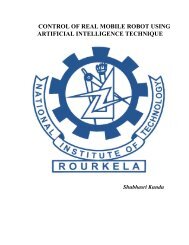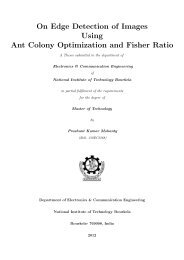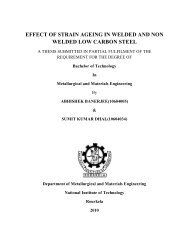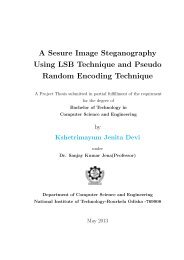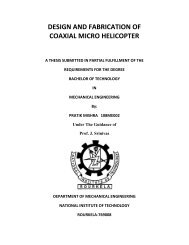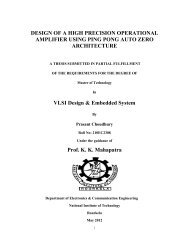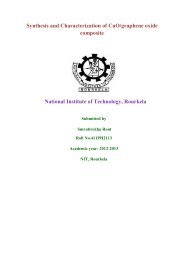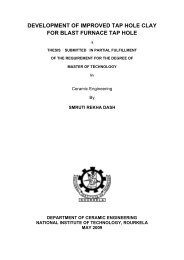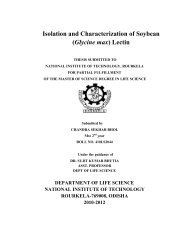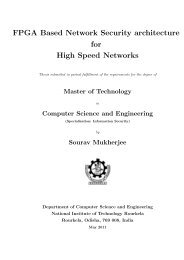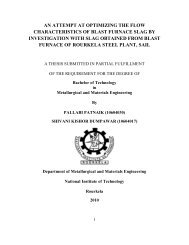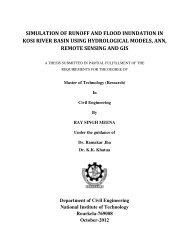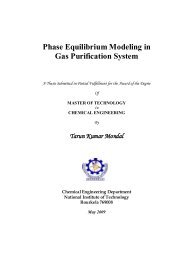analysis of transient heat conduction in different geometries - ethesis ...
analysis of transient heat conduction in different geometries - ethesis ...
analysis of transient heat conduction in different geometries - ethesis ...
Create successful ePaper yourself
Turn your PDF publications into a flip-book with our unique Google optimized e-Paper software.
A. G. Ostrogorsky [5] has used Laplace transforms, an analytical solution for <strong>transient</strong> <strong>heat</strong><br />
<strong>conduction</strong> <strong>in</strong> spheres exposed to surround<strong>in</strong>gs at a uniform temperature and f<strong>in</strong>ite Bi numbers.<br />
The solution is explicit and valid dur<strong>in</strong>g early <strong>transient</strong>s, for Fourier numbers Fo>0.3.<br />
Alhama and Campo [6] depicted a lumped model for the unsteady cool<strong>in</strong>g <strong>of</strong> a long slab by<br />
asymmetric <strong>heat</strong> convection. The authors took the plausible extension <strong>of</strong> the symmetric <strong>heat</strong><br />
convection implicat<strong>in</strong>g an asymmetric <strong>heat</strong> convection controlled by two Bi number Bi1=Lh1/k at<br />
the left surface and Bi2=Lh2/k at the right surface.<br />
Clarissa et al. [7] has depicted the <strong>transient</strong> <strong>heat</strong> <strong>conduction</strong> <strong>in</strong> a nuclear fuel rod by employ<strong>in</strong>g<br />
improved lumped parameter approach. The authors have assumed circumferential symmetry <strong>heat</strong><br />
flux through the gap modeled. Hermite approximation for <strong>in</strong>tegration is used to obta<strong>in</strong> the<br />
average temperature and <strong>heat</strong> flux <strong>in</strong> the radial direction. The authors have claimed significant<br />
improvement over the classical lumped parameter formulation. The proposed fuel rod <strong>heat</strong><br />
<strong>conduction</strong> model can be used for the stability <strong>analysis</strong> <strong>of</strong> BWR, and the real-time simulator <strong>of</strong><br />
nuclear power plants.<br />
H. Sadat [8] made an <strong>analysis</strong> on unsteady one-dimensional <strong>heat</strong> <strong>conduction</strong> problem us<strong>in</strong>g<br />
perturbation method. He has predicted the average temperature for simple first order models at<br />
the centre, and surface. He have used a slab, the <strong>in</strong>f<strong>in</strong>ite cyl<strong>in</strong>der and the sphere for the <strong>analysis</strong>.<br />
Gesu et al. [9] depicted an improved lumped-parameter models for <strong>transient</strong> <strong>heat</strong> <strong>conduction</strong> <strong>in</strong> a<br />
slab with temperature-dependent thermal conductivity. The improved lumped models are<br />
obta<strong>in</strong>ed through two po<strong>in</strong>t Hermite approximations for <strong>in</strong>tegrals. The author compared with the<br />
numerical solution <strong>of</strong> a higher order lumped model.<br />
Ziabakhsh and Domairry [ 10] analyzed has the natural convection <strong>of</strong> a non-Newtonian fluid<br />
between two <strong>in</strong>f<strong>in</strong>ite parallel vertical flat plates and the effects <strong>of</strong> the non-newtonian nature <strong>of</strong><br />
fluid on the <strong>heat</strong> transfer. The homotopy <strong>analysis</strong> method and numerical method are used for<br />
solution. The obta<strong>in</strong>ed results are valid for the whole solution doma<strong>in</strong>.<br />
Chakarborty et al. [11] presented the conditions for the validity <strong>of</strong> lumped models by compar<strong>in</strong>g<br />
with the numerical solution obta<strong>in</strong>ed by employ<strong>in</strong>g f<strong>in</strong>ite element methods.<br />
12



